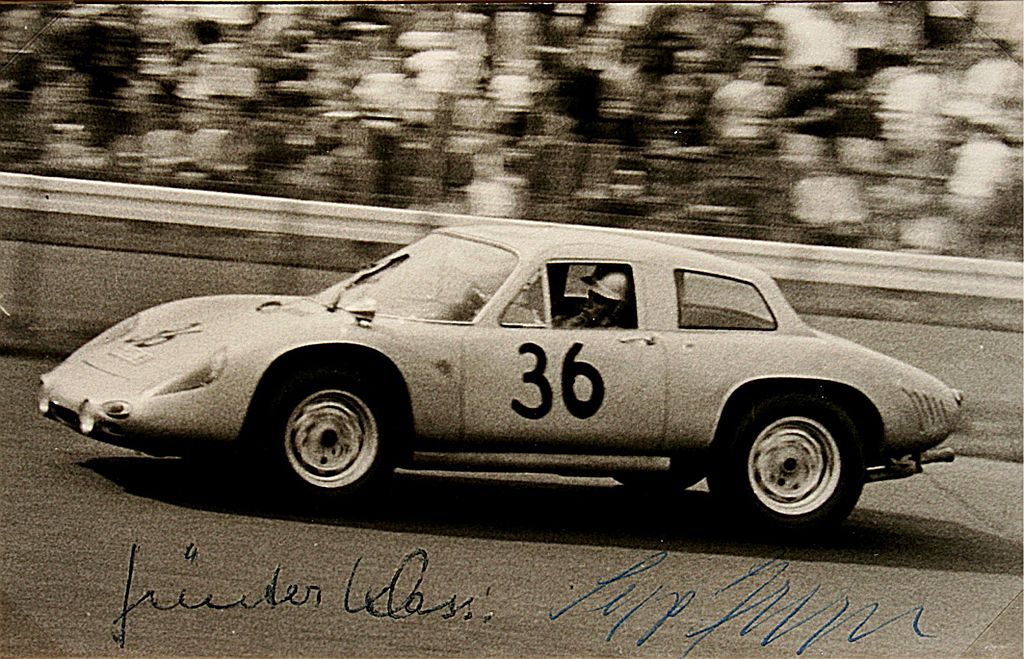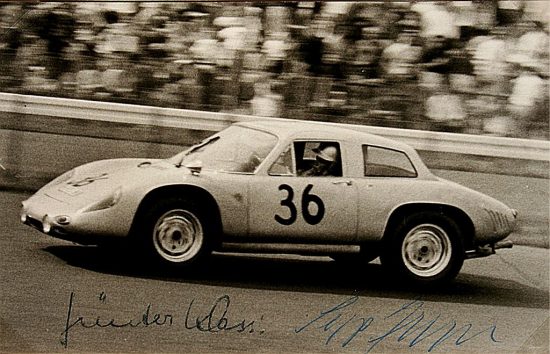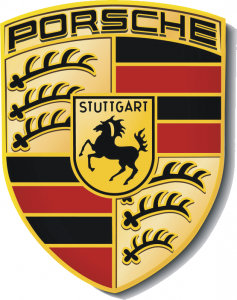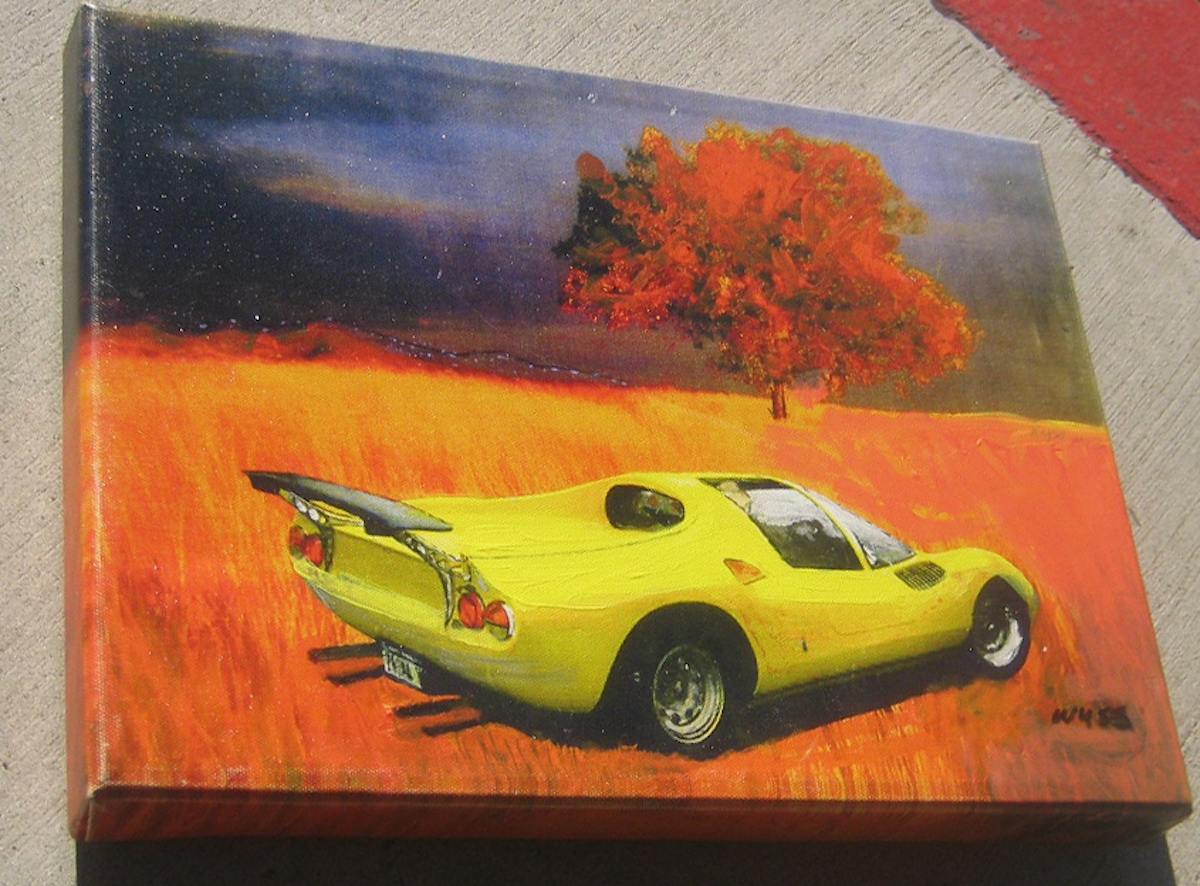OK, it was weird, it was ugly, but it’s one that got away from Porsche – the Porsche 356B 2000GS Carrera 2
– by Wallace Wyss
This is a tale both of triumph and of tragedy, yet we, as car collectors, can all learn from it.
First of all, it concerns a rare, rare Porsche. A factory race car. The production run of this model consisted of two cars. That’s it, two. The car was called the Porsche 356B 2000GS Carrera 2.
At some point, maybe 1961, 1962 or 1963 it was fitted with a new lightweight body, using part of the RS61 race car. So it was an odd combination of a low, wedge-shaped nose and an abrupt chopped off roofline instead of the rounded fastback of the Abarth Carrera GT/Ls designed by Franco Scaglione.
You might describe the roof from side view as Ferrari 250LM-like with a vertical rear window between two sail panels (except the 250LM hadn’t been unveiled yet).
At the front, there were two circular projections, into which either horns or the auxiliary road lamps could be fitted. Due to the peculiar shape of its Butzi-designed wedge shape, it was nicknamed “Dreikantschaber” (‘three-pointed scraper’) which is a tool used by clay modelers in the design studio.
At its premiere, one of the two finished well, winning overall third place in the 1963 Targa Florio and a little later one of the two was fourth at the Nürburgring. One of the two was used in 1963 and 1964 as a test car in Europe with Edgar Barth and Herbert Linge.
A three pointed scraper also ran in the U.S. in Daytona and Sebring where Porsche Stateside hero Joe Buzzetta was one of the drivers. A “Scraper” was also seen fighting in the battle for the GT-Europe Bertgmeisterschaft, where it was driven by the Swiss pilot Herbert Müller to great success.
The Scrapers were factory mules, really, never intended to be a production car or limited production road car. Why? Because the mid-engined 904GTS was being developed at the time so the three-cornered scrapers were already “old hat” as Porsche wasn’t going to make any more cars developed on the 356 floor pan, which after all, dated back to the 1940s.
A SECOND LIFE FOR A GREAT CAR
And now we come to the tragedy of the story. Oh, no one got killed. But he lost his car to a sharp trader, which to me, might even hurt worse than getting killed.
The hero of this part of the story is Portuguese race driver Américo Nunes, who at some point persuaded Porsche to sell him one of the two Porsche 356B 2000GS Carrera 2 made. It is difficult to tell which car he had because authors quoting the chassis numbers often confuse them. Author Ricardo Grilo, of Portugul, says “In my opinion, Nunes’ chassis number was # 122 922 and his German licence plate was S-RS 262.”
“I’ve observed many photos from both cars and the first one to race was the car with the large ‘B pillar.’ And for me, that first Porsche Carrera GS/GT was #122 991.”
“Nunes’ Carrera GS/GT,” says Grilo, “was the car with the narrow ‘B pillar’ and is easy to follow both cars in their racing careers. Albeit, some authors ignored the different “B pillars” of each car and in their writing assign them different chassis numbers in different races, paying no attention to the details that distinguish the two cars.”
THE SCRAPER COMPETES IN PORTUGAL
Nunes probably wrested the Porsche 356B 2000GS Carrera 2 from Porsche because they didn’t see a use for it anymore and besides, they had the other one. A 9-time Portuguese rally and racetrack champion, Nunes was a very good amateur racing driver who worked at the Portuguese Porsche importer as a bodywork expert.
He was in tight with the factory and Grilo’s opinion is that he probably bought it for a song, Porsche thinking his victories will get more attention for the Porsche brand in Portugal. Factories do that, writing a car off as sales promotion.
The car was bought by Nunes in June or July of 1965 and Nunes drove the race car from Zuffenhausen to Portugal by road, in an epic 36 hour non-stop flog, just in time to make his racing debut with the car at the Cascais circuit. In that race Nunes was forced to retire when a Lotus Elan collided with his new Porsche.
For Nunes, a hands-on guy, this was not a real problem. He always disliked the rear of the car, and as a bodywork expert, he redesigned the rear according to his own aesthetic standards borrowing more than a little of the new 904 GTS style with the sail panels and vertical rear window. All this rebodying was done in a record time as he and his friend Evaristo Saraiva were already entering the car in the Spanish Rias Bajas Rally, scheduled only two weeks after their race at Cascais!
The car was ready in time to go to Spain to the Rias Bajas Rally. Even better, they won the rally with a real Le Mans car!
That Spanish victory was most certainly the only one worldwide of a Porsche 356B 2000GS Carrera 2 in a Rally.
Two weeks latter Nunes drove the Porsche 356B 2000GS Carrera 2 to a good 2nd place overall at Vila do Conde Circuit, near Porto.
Nunes was doing so good he added a second Porsche (a 356 SC) to race in rallies but he raced both cars at every venue possible.
In 1966 Nunes again modified the rear of his Carrera 2000 GS/GT, this time going to a design similar to the Carrera Abarth. With this new look it participated in some of the events of the 1966 Portuguese Drivers Championship. But unlike his very solid and dependable 356 SC, the Carrera 2000 GS/GT was very difficult to keep running.
The sad part of the story begins here. He took it to Zuffenhausen for some work.
On the way there (or way back?) he blew the engine. Now four-cam Carrera engines are so rare there were probably no parts or no engine builder in Paris he trusted. So what does he do? He sells it to a French junk dealer in Paris.
THE ALL TIME GREAT PORSCHE DEAL
Now how much did this experienced racer sell this one-off (well, two-off…) four-cam factory race car for? It hurts me to even print the lowly figure—about $100, just enough to get a flight back to Portugal.
Today that car, has to be worth a million dollars.
(Those are my tears staining this page)
Lesson learned? Racers only think of the next race car. Porsche already had a 911 lined up for him, so he probably thought “easy come, easy go.” And he did win many subsequent races in 911 Porsches, and died decades later at a ripe old age, in his ’80s. So odds are he never missed it.
So lesson learned? Stick close to racers, your checkbook in hand. If they see a chance to get out of an obsolete car into one that’s new, you can bet that most times, they will dump that old horse in a heartbeat if they see a chance to hop into a newer ride. Which is what our chum did.
Now fast forward to present day—more than half a century later. The first “Scraper” is still at the Porsche Museum, looking good. But that second car I was searching for, thinking someone may own it and though they know it’s not a Carrera Abarth GT/L are unsure of what it was.
Well, it only took a few probes to find the owner before the present owner. He owns a winery in N. California and, by the way, invented the Stent valve. So I realize that, with the cars he now owns, that old three pointe scraper is now in the million dollar up class.
A barn finder still, I fanaticize about coming across a similar car, something that’s been restyled, so nobody knows what it is and you can buy it cheap. I realize this is akin to buying say, the Hope diamond at a swap meet where the seller thought it was a rhinestone.
Let us know what you think about the Porsche 356B 2000GS Carrera 2 in the Comments.
THE AUTHOR: Wallace Wyss is the author of Janis Joplin’s Psychedelic Porsche 356 and 49 other Great Barn Find stories. The book, and three others in the Incredible Barn Finds series, can be ordered direct from the publisher at (715) 381 9755.







I concur that was PAINFUL. I have an ISO Rivolta locked away in a Barn in Copake New York it is in Parts. I stripped the whole car and started rebuilding so I fully understand.
Agree it is not pretty but pretty darned interesting for sure… glad to see it has resurfaced…
Great story, Wallace. And I’m sure the present owner appreciates what he has — and deserves a special reward like the Scraper. His Wikipedia entry says “[his device] is estimated to have saved the lives and limbs of approximately fifteen million patients.” Legacy One, meet Legacy Two…
The reunion…
https://barchetta.mediacenter.pro/?i=1854775&rd=1964532&fd=2012032
Somewhere I read that he thought of the device while picking up a piece of scrap on his garage floor.
I wonder if it was some sort of Porsche thiggamajigger….Anyway I have at least two friends with stent valves so I am grateful too.
Great article, Wallace and Mike but please fix the following sentence:
“The hero of this part of the story is Peruvian race driver Américo Nunes, who at some point persuaded Porsche to sell him one of the two three Porsche 356B 2000GS Carrera 2 made.”
One of the two, three, or twenty three made?
Also, it’s rare enough to read something about cars driven by Portuguese race car drivers, especially since I am Portuguese. As delicious as the lomo saltado I had at a Peruvian restaurant a few days ago was, please correct Américo Nunes’ nationality as well. Thank you. ?
Miguel,
The corrections have been made – thank you for pointing this out.
Leaving great cars to die is typical. They do their job, then on to the next, not a marriage, an affair.
Think about the Cobra GT’s, and their being relegated to the back lot somewhere by Ford and eventually sold for a song.